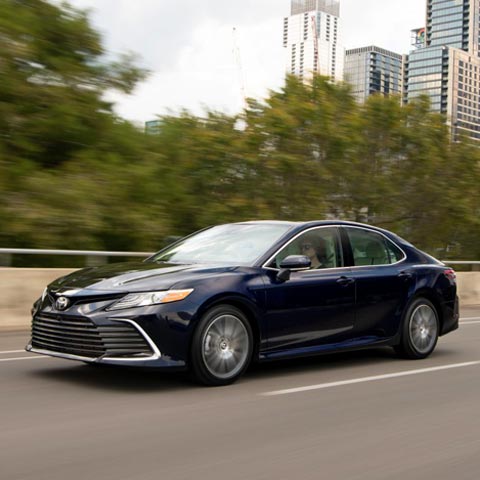Car Maintenance Basics

Learning how to check your car's fluids, tires and other wear items can save you thousands over the lifetime of the vehicle.
Published on February 1st, 2021. Last Updated on .
Owning a vehicle means that you will need to keep up with the maintenance to ensure your car or truck is safe and will last for years to come. Simple maintenance checks can easily be done at home with common hand tools for a quick weekly or monthly check. Today, we are going to look at 9 basic car maintenance tips you can perform at home to keep your vehicle running at its best.
- Checking Oil Level
- Checking Coolant Levels
- Inspecting Serpentine Belt
- Replacing Wiper Blades/Fluid
- Checking Air Filter
- Checking Tire Pressure
- Checking Tire Tread Depth
- Rotating/Balancing Tires
- Cleaning Vehicle Often
Checking Oil Level
The oil in your car's engine helps to lubricate the internal parts to reduce overheating due to friction. The oil provides a smooth, cooling factor to fast-moving engine parts. If you run low on oil, these parts will start to make more contact and wear out more quickly. Locate the dipstick in your engine bay, diagrams can be found in your owner's manual, and pull it out slowly. Run a towel across the section where the oil level indicator is and stick the dipstick back in. Wait a few seconds and pull it back out to see how much oil is in your engine. If needed, add little by little to get it within spec. Check this monthly if you suspect your car is leaking oil. Otherwise, this should be done every 3 months when you get your oil changed. Here is a video that explains this task and how to read the levels:
Checking Coolant Levels
Coolant is another vital fluid that should be checked a few times a year to ensure your engine is cooling properly. Coolant runs through your engine, extracting heat, and then passes through your radiator to cool the liquid down to repeat the process. This keeps your engine at a good operating temperature to prevent overheating. Running your vehicle with low coolant levels can cause overheating which can quickly destroy an engine. Since each car's procedure is different, check your user manual for proper coolant level checking procedures. Warning: Never attempt to open a radiator when the engine is still hot. The system is under pressure and contains extremely hot fluids. It could spray out causing severe burns and other potential injuries. Here is a helpful video on checking the coolant:
Inspecting Serpentine Belt
The serpentine belt on your vehicle controls the rotation of your engine's crankshaft and accessories. These belts are found at the front of the engine and are made from a rubber material that can deteriorate with age. Most serpentine belts are going to crack over time due to the heat cycles that they go through. With the vehicle off, visually inspect the belt to look for any signs of cracking or fraying. This is a fairly easy part to replace and is pretty cheap in most cases. Below is a video that explains what these belts do and how to inspect:
Replacing Wiper Blades/Fluid
When driving in the rain, snow, or other severe weather, the windshield wipers on your vehicle can be a lifesaver. Windshield wipers help you to see clearly for safety. Most people only realize how bad their windshield wipers are when they need them the most as they are not used until it rains. Inspecting your windshield wiper blades and the fluid levels periodically will ensure that you are never caught in the rain with ill-performing windshield wipers. You will want to look at the rubber parts of the wiper blade that make contact with your windshield and see if there are any cracks or separation. Here is a 90 second clip on how it's done:
Checking Air Filter
Every vehicle that utilizes a gas-combustion engine will have an air filter that filters out the air being brought into your engine. This air filter traps any debris, contaminants, or dirt in the air to ensure it does not make it into your intake manifold. This can cause catastrophic damage to your vehicle that may not be repairable. Locate your air filter and check it for damage and see how dirty it is. While this is a common part that is replaced during oil changes, it is always a good idea to check it yourself, especially if you live in a location that is dustier than others. Here is a brief video on why this is so important to do:
Checking Tire Pressure
The first car maintenance tip on our list is checking the tire pressure. Your tires are made to hold a specific amount of air, measured in PSI, to keep your car driving smoothly and allow for your tires to wear evenly. The recommended tire pressure for your vehicle can be found in your manual, on a decal in the door jam of your driver's door, or online from a reputable source. You will want to maintain the specified tire pressure year-round to ensure vehicle safety. Tires that are underinflated can cause outer tread wear, lower fuel economy, and decreased overall performance from your vehicle. Overinflated tires will cause excessive inner tread wear, decreased traction, and will run a higher risk of blowing out. Use a common air pressure gauge to quickly check your tires every time you fill up to stay on a good schedule. Here is a short video on how to check and inflate your tires:
Checking Tire Tread Depth
The tread on your tires is used to help give you traction in wet and dry conditions. Tire tread under 2/32nds of an inch will not pass inspection and will need to be replaced. You can check your tire's tread depth using a special tire depth tool or you can use a penny to give you an easy way to check. Using a penny, insert the coin into the tread with Lincoln's head facing down. If the tread is down below the top of his head, it is time to replace your tires. Tires with less tread will have less traction, posing a serious danger when driving in any condition. Here is a short video on how to do this with a penny:
Rotating/Balancing Tires
Rotating and balancing your tires will ensure that your tires are wearing evenly and providing a smooth ride. Rotating your tires refers to removing your wheels and tires and putting them on opposite sides of your vehicle. This is usually done from front to back and side to side in an X pattern. This allows your tires to evenly wear as the wheels you use to turn wear more quickly due to more friction. Balancing your tires is a common practice that should be done as frequently as your user manual states. This ensures your tires do not vibrate when driving. The following video explains the process and best practices:
Cleaning Vehicle Often
Last but not least, you will want to clean your car often. While this will not be as much of a safety concern as the tips above, it will keep your car clean and free from premature wear. A car’s paint can quickly fade if not taken care of properly. Getting into a good habit of washing your vehicle monthly and waxing it twice a year should keep your paint nice and protected for years to come. Here are some great tips on the right methods of washing your car:
Dealer Vs Repair Shop Costs
If you are looking to get work done on your vehicle, cost is one of the biggest determining factors. Car repairs and maintenance jobs can vary in price from shop to shop, but there is usually a bigger difference when looking at dealership prices vs repair shop prices. A dealership is going to charge more due to the larger overhead costs that are involved with running a dealership. Smaller repair shops can often charge less since their overhead costs are much lower. However, dealerships are going to have highly-trained technicians for their specific model cars which may be worth the extra cost.








